International Business Essay: NZ-China Trade and Cultural Impact
VerifiedAdded on 2019/11/26
|5
|1187
|182
Essay
AI Summary
This essay provides an in-depth analysis of the international business relationship between New Zealand and China, emphasizing the significant impact of cultural differences on trade dynamics. It begins with an overview of the increasing export volume from New Zealand to China, highlighting key goods and services. The essay then delves into the cultural disparities between the two countries, particularly focusing on Hofstede's cultural dimensions, with a comparison of individualism. It explores specific challenges faced by New Zealand managers, such as differing business approaches and communication barriers due to language and cultural nuances like the concept of 'Face'. The essay concludes by summarizing lessons learned, emphasizing the importance of understanding Chinese business practices, long-term perspectives, and the need for cross-cultural training to ensure successful international business ventures. The essay stresses the need for understanding cultural aspects and norms of China to facilitate smoother business operations and calls for appropriate cross-cultural training for managers to promote efficiency in international business.
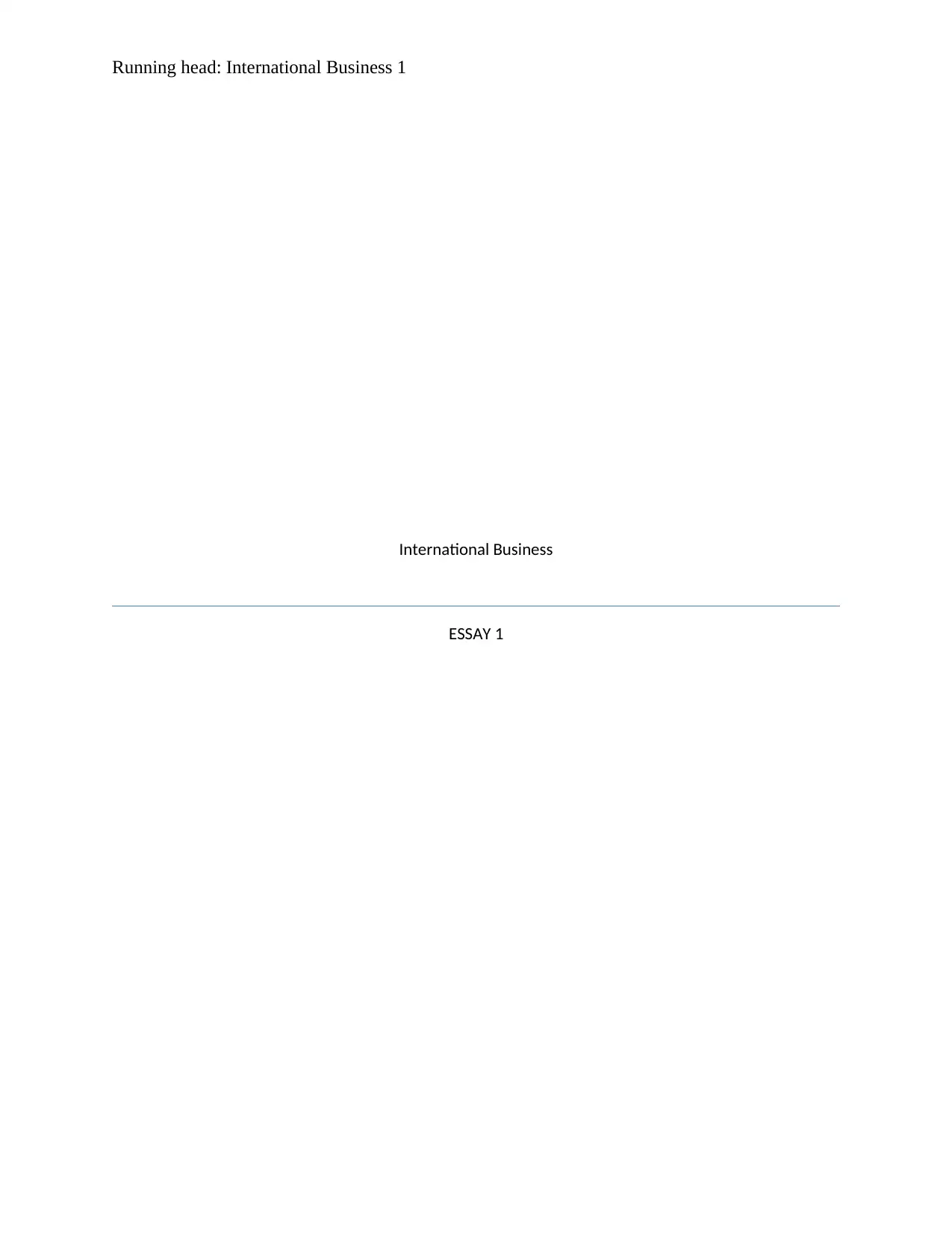
Running head: International Business 1
International Business
ESSAY 1
International Business
ESSAY 1
Paraphrase This Document
Need a fresh take? Get an instant paraphrase of this document with our AI Paraphraser
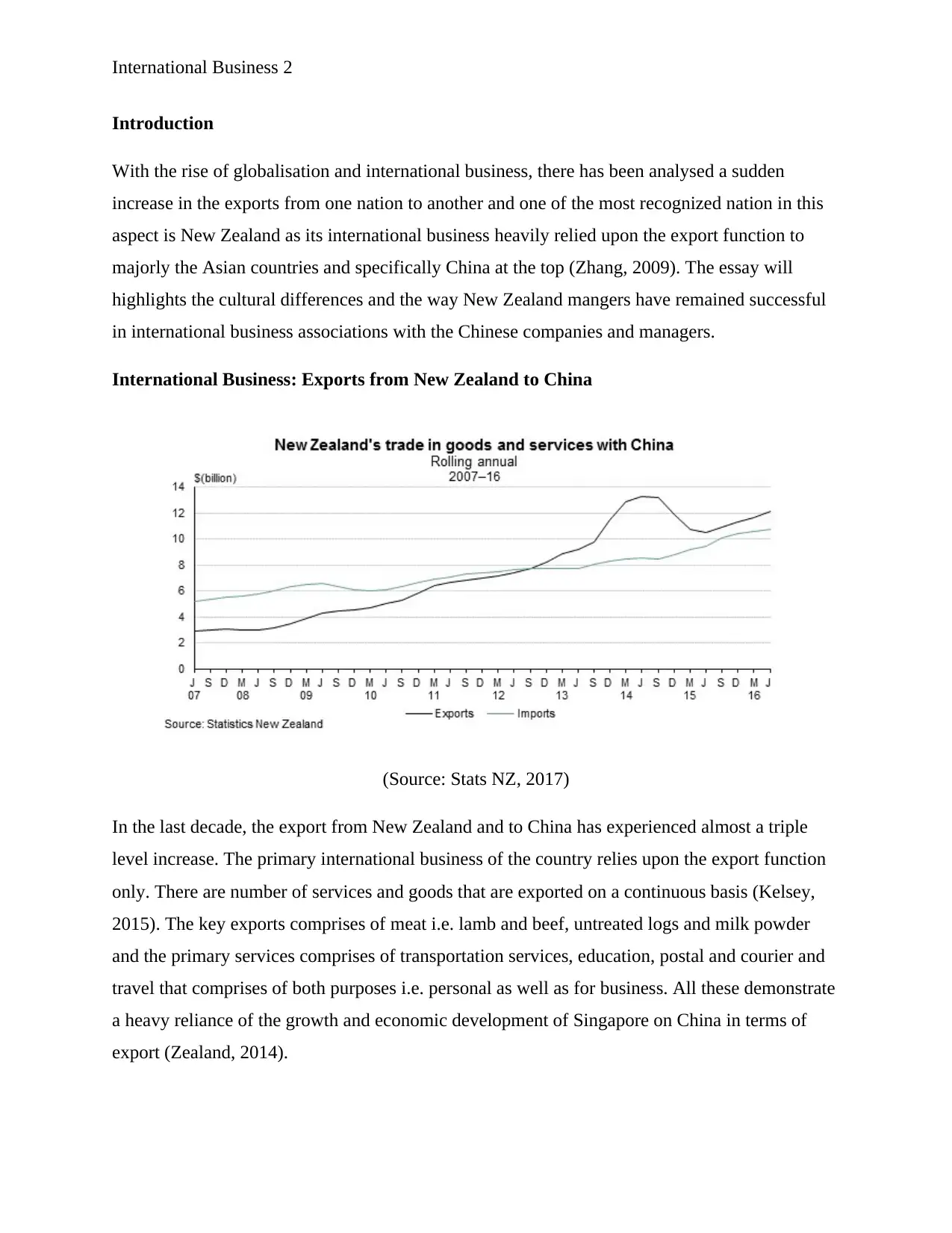
International Business 2
Introduction
With the rise of globalisation and international business, there has been analysed a sudden
increase in the exports from one nation to another and one of the most recognized nation in this
aspect is New Zealand as its international business heavily relied upon the export function to
majorly the Asian countries and specifically China at the top (Zhang, 2009). The essay will
highlights the cultural differences and the way New Zealand mangers have remained successful
in international business associations with the Chinese companies and managers.
International Business: Exports from New Zealand to China
(Source: Stats NZ, 2017)
In the last decade, the export from New Zealand and to China has experienced almost a triple
level increase. The primary international business of the country relies upon the export function
only. There are number of services and goods that are exported on a continuous basis (Kelsey,
2015). The key exports comprises of meat i.e. lamb and beef, untreated logs and milk powder
and the primary services comprises of transportation services, education, postal and courier and
travel that comprises of both purposes i.e. personal as well as for business. All these demonstrate
a heavy reliance of the growth and economic development of Singapore on China in terms of
export (Zealand, 2014).
Introduction
With the rise of globalisation and international business, there has been analysed a sudden
increase in the exports from one nation to another and one of the most recognized nation in this
aspect is New Zealand as its international business heavily relied upon the export function to
majorly the Asian countries and specifically China at the top (Zhang, 2009). The essay will
highlights the cultural differences and the way New Zealand mangers have remained successful
in international business associations with the Chinese companies and managers.
International Business: Exports from New Zealand to China
(Source: Stats NZ, 2017)
In the last decade, the export from New Zealand and to China has experienced almost a triple
level increase. The primary international business of the country relies upon the export function
only. There are number of services and goods that are exported on a continuous basis (Kelsey,
2015). The key exports comprises of meat i.e. lamb and beef, untreated logs and milk powder
and the primary services comprises of transportation services, education, postal and courier and
travel that comprises of both purposes i.e. personal as well as for business. All these demonstrate
a heavy reliance of the growth and economic development of Singapore on China in terms of
export (Zealand, 2014).
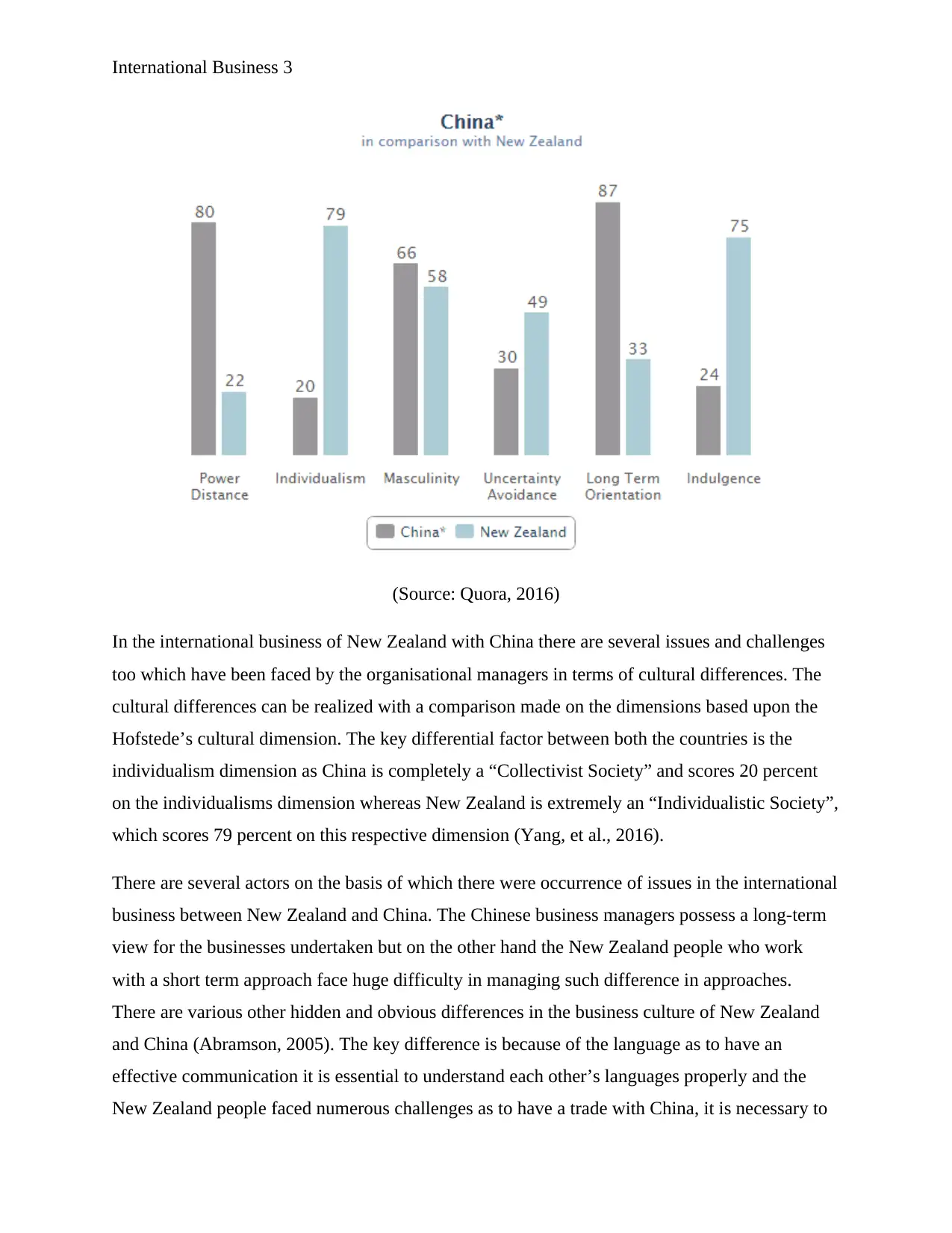
International Business 3
(Source: Quora, 2016)
In the international business of New Zealand with China there are several issues and challenges
too which have been faced by the organisational managers in terms of cultural differences. The
cultural differences can be realized with a comparison made on the dimensions based upon the
Hofstede’s cultural dimension. The key differential factor between both the countries is the
individualism dimension as China is completely a “Collectivist Society” and scores 20 percent
on the individualisms dimension whereas New Zealand is extremely an “Individualistic Society”,
which scores 79 percent on this respective dimension (Yang, et al., 2016).
There are several actors on the basis of which there were occurrence of issues in the international
business between New Zealand and China. The Chinese business managers possess a long-term
view for the businesses undertaken but on the other hand the New Zealand people who work
with a short term approach face huge difficulty in managing such difference in approaches.
There are various other hidden and obvious differences in the business culture of New Zealand
and China (Abramson, 2005). The key difference is because of the language as to have an
effective communication it is essential to understand each other’s languages properly and the
New Zealand people faced numerous challenges as to have a trade with China, it is necessary to
(Source: Quora, 2016)
In the international business of New Zealand with China there are several issues and challenges
too which have been faced by the organisational managers in terms of cultural differences. The
cultural differences can be realized with a comparison made on the dimensions based upon the
Hofstede’s cultural dimension. The key differential factor between both the countries is the
individualism dimension as China is completely a “Collectivist Society” and scores 20 percent
on the individualisms dimension whereas New Zealand is extremely an “Individualistic Society”,
which scores 79 percent on this respective dimension (Yang, et al., 2016).
There are several actors on the basis of which there were occurrence of issues in the international
business between New Zealand and China. The Chinese business managers possess a long-term
view for the businesses undertaken but on the other hand the New Zealand people who work
with a short term approach face huge difficulty in managing such difference in approaches.
There are various other hidden and obvious differences in the business culture of New Zealand
and China (Abramson, 2005). The key difference is because of the language as to have an
effective communication it is essential to understand each other’s languages properly and the
New Zealand people faced numerous challenges as to have a trade with China, it is necessary to
⊘ This is a preview!⊘
Do you want full access?
Subscribe today to unlock all pages.

Trusted by 1+ million students worldwide
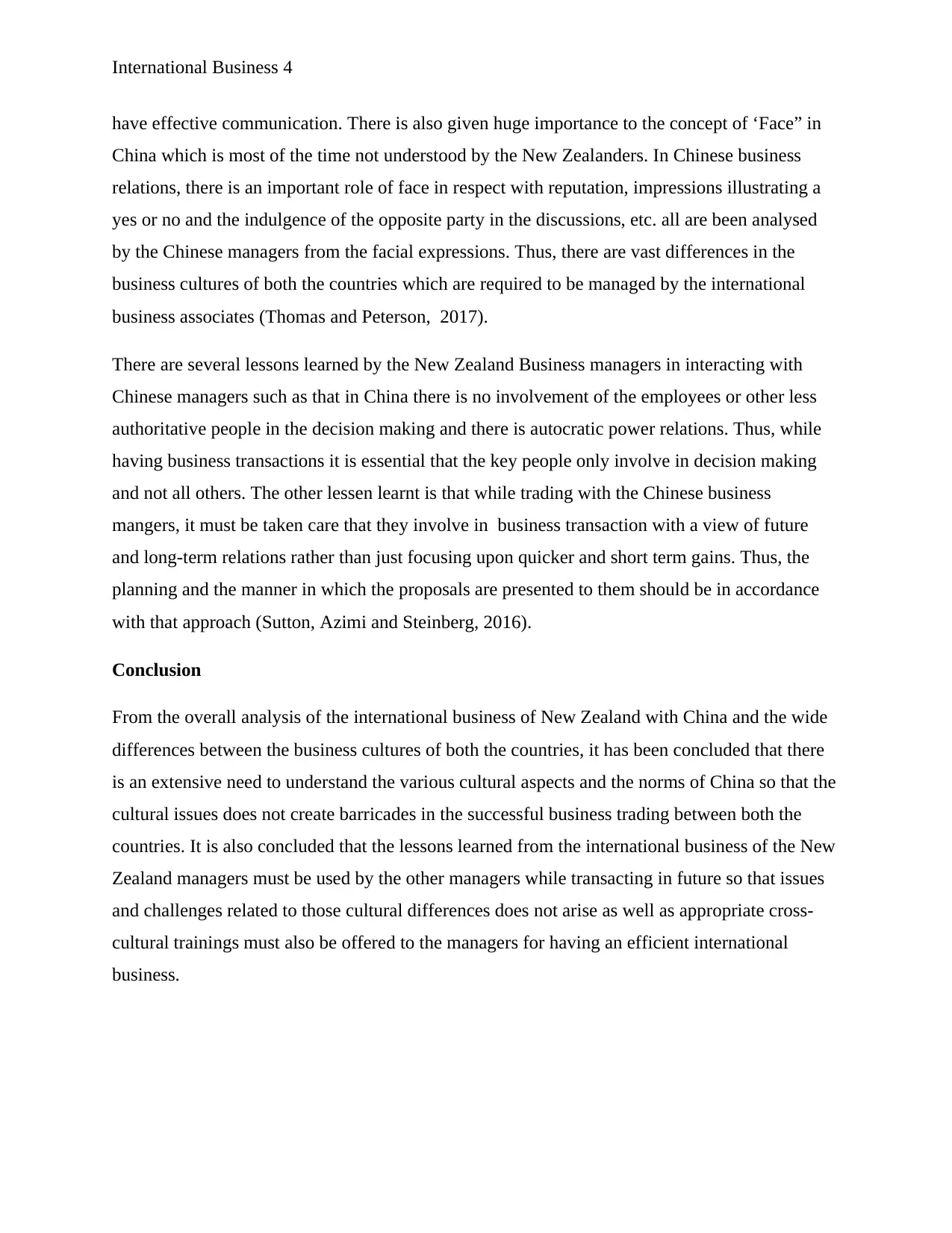
International Business 4
have effective communication. There is also given huge importance to the concept of ‘Face” in
China which is most of the time not understood by the New Zealanders. In Chinese business
relations, there is an important role of face in respect with reputation, impressions illustrating a
yes or no and the indulgence of the opposite party in the discussions, etc. all are been analysed
by the Chinese managers from the facial expressions. Thus, there are vast differences in the
business cultures of both the countries which are required to be managed by the international
business associates (Thomas and Peterson, 2017).
There are several lessons learned by the New Zealand Business managers in interacting with
Chinese managers such as that in China there is no involvement of the employees or other less
authoritative people in the decision making and there is autocratic power relations. Thus, while
having business transactions it is essential that the key people only involve in decision making
and not all others. The other lessen learnt is that while trading with the Chinese business
mangers, it must be taken care that they involve in business transaction with a view of future
and long-term relations rather than just focusing upon quicker and short term gains. Thus, the
planning and the manner in which the proposals are presented to them should be in accordance
with that approach (Sutton, Azimi and Steinberg, 2016).
Conclusion
From the overall analysis of the international business of New Zealand with China and the wide
differences between the business cultures of both the countries, it has been concluded that there
is an extensive need to understand the various cultural aspects and the norms of China so that the
cultural issues does not create barricades in the successful business trading between both the
countries. It is also concluded that the lessons learned from the international business of the New
Zealand managers must be used by the other managers while transacting in future so that issues
and challenges related to those cultural differences does not arise as well as appropriate cross-
cultural trainings must also be offered to the managers for having an efficient international
business.
have effective communication. There is also given huge importance to the concept of ‘Face” in
China which is most of the time not understood by the New Zealanders. In Chinese business
relations, there is an important role of face in respect with reputation, impressions illustrating a
yes or no and the indulgence of the opposite party in the discussions, etc. all are been analysed
by the Chinese managers from the facial expressions. Thus, there are vast differences in the
business cultures of both the countries which are required to be managed by the international
business associates (Thomas and Peterson, 2017).
There are several lessons learned by the New Zealand Business managers in interacting with
Chinese managers such as that in China there is no involvement of the employees or other less
authoritative people in the decision making and there is autocratic power relations. Thus, while
having business transactions it is essential that the key people only involve in decision making
and not all others. The other lessen learnt is that while trading with the Chinese business
mangers, it must be taken care that they involve in business transaction with a view of future
and long-term relations rather than just focusing upon quicker and short term gains. Thus, the
planning and the manner in which the proposals are presented to them should be in accordance
with that approach (Sutton, Azimi and Steinberg, 2016).
Conclusion
From the overall analysis of the international business of New Zealand with China and the wide
differences between the business cultures of both the countries, it has been concluded that there
is an extensive need to understand the various cultural aspects and the norms of China so that the
cultural issues does not create barricades in the successful business trading between both the
countries. It is also concluded that the lessons learned from the international business of the New
Zealand managers must be used by the other managers while transacting in future so that issues
and challenges related to those cultural differences does not arise as well as appropriate cross-
cultural trainings must also be offered to the managers for having an efficient international
business.
Paraphrase This Document
Need a fresh take? Get an instant paraphrase of this document with our AI Paraphraser
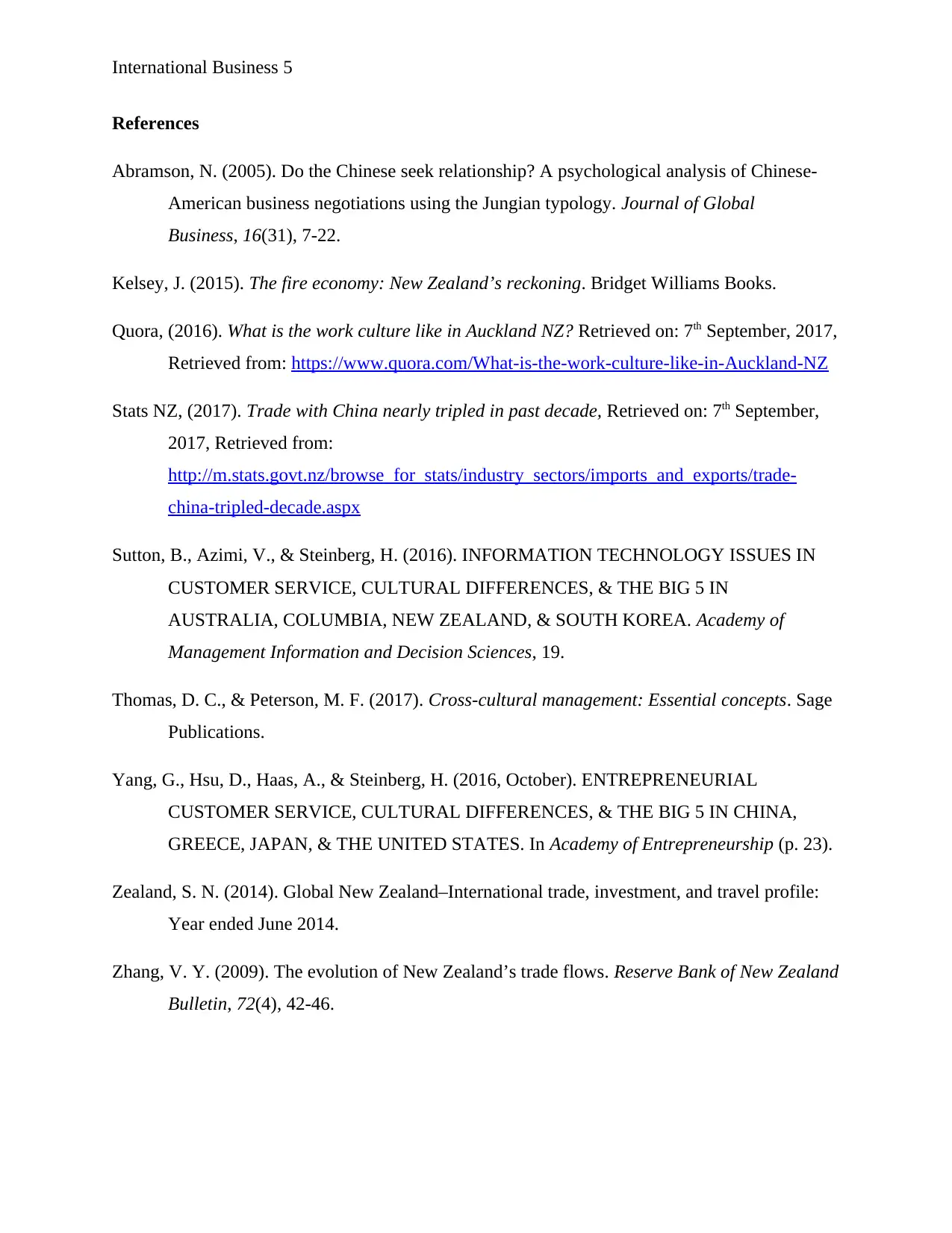
International Business 5
References
Abramson, N. (2005). Do the Chinese seek relationship? A psychological analysis of Chinese-
American business negotiations using the Jungian typology. Journal of Global
Business, 16(31), 7-22.
Kelsey, J. (2015). The fire economy: New Zealand’s reckoning. Bridget Williams Books.
Quora, (2016). What is the work culture like in Auckland NZ? Retrieved on: 7th September, 2017,
Retrieved from: https://www.quora.com/What-is-the-work-culture-like-in-Auckland-NZ
Stats NZ, (2017). Trade with China nearly tripled in past decade, Retrieved on: 7th September,
2017, Retrieved from:
http://m.stats.govt.nz/browse_for_stats/industry_sectors/imports_and_exports/trade-
china-tripled-decade.aspx
Sutton, B., Azimi, V., & Steinberg, H. (2016). INFORMATION TECHNOLOGY ISSUES IN
CUSTOMER SERVICE, CULTURAL DIFFERENCES, & THE BIG 5 IN
AUSTRALIA, COLUMBIA, NEW ZEALAND, & SOUTH KOREA. Academy of
Management Information and Decision Sciences, 19.
Thomas, D. C., & Peterson, M. F. (2017). Cross-cultural management: Essential concepts. Sage
Publications.
Yang, G., Hsu, D., Haas, A., & Steinberg, H. (2016, October). ENTREPRENEURIAL
CUSTOMER SERVICE, CULTURAL DIFFERENCES, & THE BIG 5 IN CHINA,
GREECE, JAPAN, & THE UNITED STATES. In Academy of Entrepreneurship (p. 23).
Zealand, S. N. (2014). Global New Zealand–International trade, investment, and travel profile:
Year ended June 2014.
Zhang, V. Y. (2009). The evolution of New Zealand’s trade flows. Reserve Bank of New Zealand
Bulletin, 72(4), 42-46.
References
Abramson, N. (2005). Do the Chinese seek relationship? A psychological analysis of Chinese-
American business negotiations using the Jungian typology. Journal of Global
Business, 16(31), 7-22.
Kelsey, J. (2015). The fire economy: New Zealand’s reckoning. Bridget Williams Books.
Quora, (2016). What is the work culture like in Auckland NZ? Retrieved on: 7th September, 2017,
Retrieved from: https://www.quora.com/What-is-the-work-culture-like-in-Auckland-NZ
Stats NZ, (2017). Trade with China nearly tripled in past decade, Retrieved on: 7th September,
2017, Retrieved from:
http://m.stats.govt.nz/browse_for_stats/industry_sectors/imports_and_exports/trade-
china-tripled-decade.aspx
Sutton, B., Azimi, V., & Steinberg, H. (2016). INFORMATION TECHNOLOGY ISSUES IN
CUSTOMER SERVICE, CULTURAL DIFFERENCES, & THE BIG 5 IN
AUSTRALIA, COLUMBIA, NEW ZEALAND, & SOUTH KOREA. Academy of
Management Information and Decision Sciences, 19.
Thomas, D. C., & Peterson, M. F. (2017). Cross-cultural management: Essential concepts. Sage
Publications.
Yang, G., Hsu, D., Haas, A., & Steinberg, H. (2016, October). ENTREPRENEURIAL
CUSTOMER SERVICE, CULTURAL DIFFERENCES, & THE BIG 5 IN CHINA,
GREECE, JAPAN, & THE UNITED STATES. In Academy of Entrepreneurship (p. 23).
Zealand, S. N. (2014). Global New Zealand–International trade, investment, and travel profile:
Year ended June 2014.
Zhang, V. Y. (2009). The evolution of New Zealand’s trade flows. Reserve Bank of New Zealand
Bulletin, 72(4), 42-46.
1 out of 5
Related Documents
Your All-in-One AI-Powered Toolkit for Academic Success.
+13062052269
info@desklib.com
Available 24*7 on WhatsApp / Email
![[object Object]](/_next/static/media/star-bottom.7253800d.svg)
Unlock your academic potential
Copyright © 2020–2025 A2Z Services. All Rights Reserved. Developed and managed by ZUCOL.





